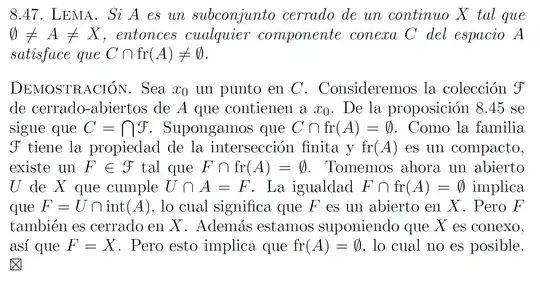What shown below is a reference from "Elementos de Topología General" by Fidel Cassarubias Segura and Ángel Tamariz Mascarúa
Lemma
If $X$ is continuum and if $A$ is closed in $X$ then $C\cap\partial A\neq\varnothing$ for any component $C$ of $A$.
Proof. Let be $x_0\in C$ and so we consider the collection $\mathcal{F}$ of clopen sets of $A$ that contain $x_0$. So we know that $C=\bigcap\mathcal{F}$. Therefore we suppose that $C\cap\partial A=\varnothing$. So since $\mathcal{F}$ has the finite intersection property and since $\partial A$ is compact then there exist $F\in\mathcal{F}$ such that $F\cap\partial A=\varnothing$. So we choose an open set $U$ of $X$ such that $U\cap A=F$. So if $F\cap\partial A=\varnothing$ then $F=U\cap A^°$ and so $F$ is open in $X$; however $F$ is closed in $X$ and so if $X$ is connected it follows that $F=X$ and so $\partial A=\varnothing$ that is impossible.
For sake of completeness here is the original text of the proof: I hope mine was a good translation.
Well I don't understand why there exist $F\in\mathcal{F}$ such that $F\cap\partial A=\varnothing$. So could someone explain this to me, please?
